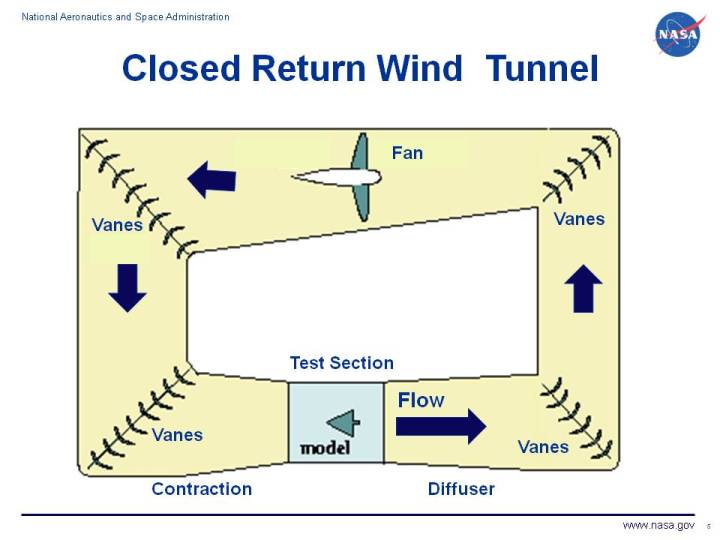
Wind tunnels
are designed for a specific purpose and
speed range.
Therefore, there are many different
types of wind tunnels
and several different ways to classify wind tunnels.
In this section of the website we shall
present various types of wind tunnels and discuss some of the unique features
of each type of tunnel.
On the figure, we show a schematic drawing of an closed return wind tunnel.
This type of tunnnel is also called an Prandtl tunnel, after the German engineer,
or a Gottingen tunnel , after the research laboratory in Germany where the tunnel
was first used. Many of the large research
wind tunnels
of NASA are closed return tunnels.
In the closed return tunnel, air is conducted from the exit of the
test section
back to the fan by a series of turning vanes. Exiting the fan, the air is returned
to the contraction section and back through the test section. Air is continuously
circulated through the duct work of the closed return tunnel.
The arrows on the figure
denote the flow of air through the wind tunnel.
In the other major tunnel design,
the open return tunnel,
air that passes through the test section
is gathered from the room in which the tunnel is located.
Closed return tunnels may operate subsonically, as shown in the figure, or supersonically,
as described on a
separate page.
Supersonic closed return tunnels are more complex than subsonic tunnels. To prevent
condensation in the test section because of
low pressure, the air entering the tunnel is often passed
over a dryer bed. There is usually an additional throat placed in the tunnel downstream
of the test section to
shock down
the supersonic flow to subsonic. The advantage of a supersonic continuous flow wind tunnel
is the longer run times relative to
a blowdown tunnel.
The major disadvantage is the increased size and operating costs.
The closed return tunnel has some advantages and some disadvantages relative to the open
return tunnel.
Advantages of the Closed Return Tunnel
-
Superior flow quality in the test section. Flow turning vanes in the corner and flow straighteners
near the test section insure relatively uniform flow in the test section.
-
Low operating costs. Once the air is circulating in the tunnel, the fan and motor only needs
to overcome losses along the wall and through the turning vanes. The fan does not have to
constantly accelerate the air.
-
Quiet operation relative to an open return tunnel.
Disadvantages of the Closed Return Tunnel
-
Higher construction cost because of the added vanes and ducting.
-
Inferior design for propulsion and smoke visualization. The tunnel must be designed to
purge exhaust products that accumulate in the tunnel.
-
Hotter running conditions than an open return tunnel. Tunnel may have to employ heat
exchangers or active cooling.
Navigation ..


- Beginner's Guide Home Page
|
